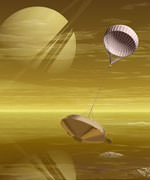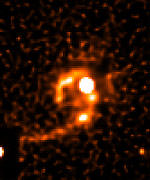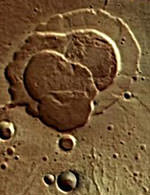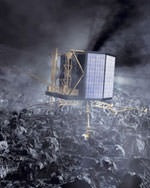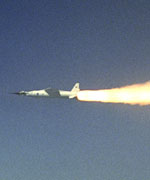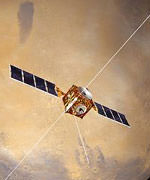
Image credit: ESA
Will swarms of co-operating robots one day be exploring some of the most intriguing worlds in the solar system? James Law, an engineer who is a doctoral student at the Open University, supports the idea that using whole teams of robotic explorers working together offers distinct advantages, especially when it comes to tackling the challenges presented by remote bodies such as Europa and Titan. In a presentation on Wednesday 31 March at the Royal Astronomical Society’s National Astronomy Meeting at the Open University, he will be reviewing some current ideas on co-operative robot technology and suggesting how it might be applied to a Titan mission with a concept for a ‘Master’ robot controlling a bevy of ‘Slaves’.
Of the 17 landers sent to investigate Mars, only 5 have survived to perform their missions. In spite of this, scientists are already looking for their next planetary targets, with Saturn’s moon Titan and Jupiter’s moon Europa being distinct possibilities. Given both the greater distances involved, and extreme climatic conditions, how can the likelihood of a successful robotic surface mission be increased? Although robotic rovers have become the preferred choice over static landers, due to their greater versatility, the addition of motion systems increases their weight and reduces the reliability of these already complex mechanisms.
Advantages of teamwork
One alternative, proposed in 1989 by Rodney Brooks of the Massachusetts Institute of Technology, is finally coming to fruition – the idea of replacing solitary rovers with swarms of cooperative robots. With scientific equipment evenly distributed between them, each rover can be made smaller, lighter, and less complex. These robots can then work together or independently, in order to complete the mission objectives.
This approach has several distinct advantages. Launch costs could be reduced and soft landings achieved by delivering lighter payloads. Robustness is improved, since a critical failure on any rover is isolated from the rest. Although losing a rover may restrict the capabilities of the swarm, it is not likely to result in termination of the mission. Indeed, in many cases the affected rover will still be able to play a useful, though limited role.
Robotic swarms permit a variety of new missions, such as simultaneous measurements over wide areas, useful in climate monitoring and seismic sounding, or multiple experiments performed concurrently by different robots. Rovers can also work together to access areas of greater scientific interest, for example cliff faces. James Law cites David Barnes of the University of Wales at Aberystwyth, who is developing a swarm of aerobots – flying robots which could be used for terrain mapping or deploying smaller micro rovers. Another benefit of using small cooperative rovers is that additional robots can be launched and integrated into the swarm to extend a mission, enabling new experiments, or replacement of lost and damaged rovers.
Robots for Titan
In his talk, James Law will present his own vision for a mission to Titan. Though we have to wait for the Huygens probe, due to land on Titan early next year, to discover the true nature of Titan’s surface, it is likely to be mixed. “In this situation, a Master-Slave robot configuration with a variety of transport modes could be favourable,” he suggests. “A ‘Master’ lander supplying power and communications provides an outpost for a number of small ‘Slave’ rovers and balloons. The lander would be equipped with a range of scientific packages, which it could distribute amongst its slave robots depending on the environment around the landing site. These subordinate robots are then able to act either cooperatively – for example, to dig and image a trench in order to investigate its geological layers – or on their own, analysing or collecting samples and returning them to the lander for more in-depth analysis. The rovers would return to the lander to recharge their batteries and change their scientific payloads. Robots capable of operating in a liquid environment could be dispersed on any Titan sea to measure wave motion, perhaps by balloon, then be sacrificed, by ‘drowning’, to measure conditions below the surface.”
Exploring Europa
Among schemes proposed by others that James Law will review is one for the exploration of Europa, devised by Jeff Johnson of the Open University and Rodney Buckland of the University of Kent. It involves Self Organising IMAging Robots, or soimars, small cube-shaped robots each carrying a single-pixel imaging device (such as a photodiode) and weighing as little as 10 grams. Each one is able to communicate with its neighbours and is capable of moving in water, using small propulsion screws. A swarm of these tiny robots could be deployed into a sub surface ocean on Europa to image the environment.
A transport craft containing communications and power facilities would land on Europa’s ice crust and release an ice-penetrating device containing the soimars. This device would bore through the ice and release the soimars into the ocean. The soimars then self-organise into a stack, aligning their imaging devices. By cooperatively swimming, the stack scans an area under the ice. If a single imaging device fails, the faulty soimar is simply released and the swarm reorganises to form an error free array. This also enables more soimars, perhaps from subsequent landers, to join the swarm and improve the image resolution. In this configuration, the soimars are physically attached to one another. An alternative use would be to equip them with touch sensors and have them swim as a dispersed cloud along the ocean floor, mapping its elevation. A simulation has been developed at the Open University to demonstrate the self-organising behaviour of the swarm.
A mechanical workforce for Mars
The Jet Propulsion Laboratory (JPL) has research underway on cooperative robot teams, including robotic work crews for carrying large items, robotic excavation teams, and robots that can rappel one another down steep cliff faces. An objective of this work at JPL is to deploy a robotic workforce on Mars to construct mining and refining facilities, which will provide fuel for future human missions. With proposals to land men on Mars, and eventually more distant locations, these robotic work crews will be indispensable in both investigating the destinations, and creating outposts to support our arrival.
Original Source: RAS News Release

